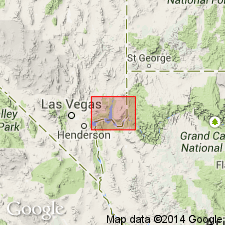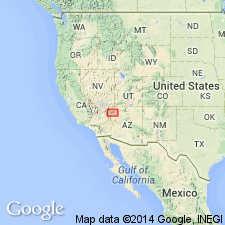
- Usage in publication:
-
- Tassai Wash group
- Modifications:
-
- Named
- Dominant lithology:
-
- Breccia
- Sandstone
- Limestone
- AAPG geologic province:
-
- Plateau sedimentary province
Summary:
Named for exposures in Tassai Wash, northeast tributary of Grand Wash, Mohave Co, AZ in the Plateau sedimentary province. No type locality designated. Unconformably above Kaibab limestone. Mapped in some earlier reports as part of Moenkopi formation. Does not resemble any part of the Moenkopi. Section 360+ ft thick measured in Tassai Wash. Has a 60 ft thick basal well-cemented breccia of limestone and chert. Some fragments in the breccia are as much as 30 in long. Basal unit overlain by buff siltstone, limestone and sandstone. Is probably Tertiary, pre-Pliocene age. Geologic map.
Source: GNU records (USGS DDS-6; Denver GNULEX).

- Usage in publication:
-
- Tassai Wash Group
- Modifications:
-
- Not used
Summary:
Exposed within 25 mi of Horse Spring, eastern Clark Co, NV. Is lithologically and stratigraphically similar to the Horse Spring Formation. Is considered to be the equivalent to the lower half of the Horse Spring Formation of this report. Term Tassai Wash Group not used.
Source: GNU records (USGS DDS-6; Denver GNULEX).
For more information, please contact Nancy Stamm, Geologic Names Committee Secretary.
Asterisk (*) indicates published by U.S. Geological Survey authors.
"No current usage" (†) implies that a name has been abandoned or has fallen into disuse. Former usage and, if known, replacement name given in parentheses ( ).
Slash (/) indicates name conflicts with nomenclatural guidelines (CSN, 1933; ACSN, 1961, 1970; NACSN, 1983, 2005, 2021). May be explained within brackets ([ ]).

